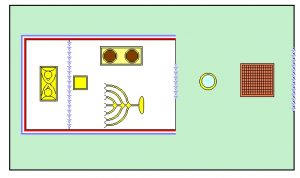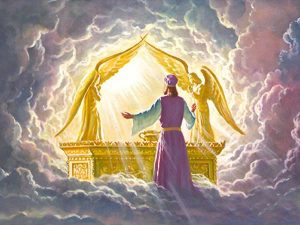This week we narrow our study of the sanctuary to the one that Moses was told to build after almost 400 years of oppressive slavery in Egypt. Not only were they to learn more about God in a simple, concrete form, but God was very anxious to be as near to them as possible to provide comfort and protection as they wandered in the wilderness on the way to Canaan.
Our memory text puts forth this idea of God being with them. It reminds us of the name of Jesus: Immanuel, or God with us (Matthew 1:23). This has long been God’s desire, to be with His people.
Memory Text: “And let them make me a sanctuary; that I may dwell among them.” Exodus 25:8 KJV
Some of the greatest lessons to be derived from the sanctuary are found in the book of Psalms. As a matter of fact, out of the 150 psalms we find an average of one explicit reference to the sanctuary per psalm. Psalm 27, however, has more to tell us about the sanctuary than any of the others.
There we find David directing us to the beauty, truth, and goodness found in the sanctuary. These three values are what some philosophers have termed the “triple star of value”. They are the qualities that we find most worthy in life, and even the ones worth dying for. [teacher’s helps]
Sunday: Place of the Presence
In Numbers 2 we see that the place for the tabernacle was to be in the very center of the square encampment. In the Near East this was the customary place for a king’s tent. Symbolically then, God is King over Israel at this time.
The Levites placed their tents around the tabernacle, and then the other tribes around them (Numbers 1:53; 2:2).
Discussion Question: What do you see as the reason behind such an orderly placement of the tents, with God’s tabernacle in the center?
Monday: “Be Ye Holy”
Exodus 40:9, 10 reveals the anointing of the sanctuary in order to make it holy. We recall Jesus’ anointing which occurred at His baptism. Evidently, “holiness of heart and purity of life, reverence for God, and strict obedience to His requirements” should be maintained by all connected with the sanctuary. These are the prerequisites for serving God and glorifying Him with whatever ministry He has called us to.
Keep in mind though that it is God’s holiness that transforms us and sets us apart as holy. This growth in holiness that God has designed for us can only happen through a complete surrender of self and our sinful natures. We must be willing to do what is right, no matter the consequence. This standard was not just for the Levites. See I Peter 1:14-16.
Thought Question: How many of your tastes, activities, and habits would be considered “holy”? Could you participate in them with Jesus by your side?
Tuesday: Instruments of the Sanctuary
 So much could be said and studied from the instruments or furniture in the tabernacle service. Each piece represents a part of the gospel puzzle and where we as individuals or churches find ourselves in the plan of salvation timeline.
So much could be said and studied from the instruments or furniture in the tabernacle service. Each piece represents a part of the gospel puzzle and where we as individuals or churches find ourselves in the plan of salvation timeline.
Many feel that our time in history puts us right at the door of the Most Holy Place, waiting for the Day of Atonement to be completed. This was the only day the High Priest entered the Most Holy Place. It was a time of intense soul-searching and prayer.
When you look at the floor plan of the tabernacle furniture, you might notice it has the shape of a cross. Following the steps into the tabernacle, we find they coincide with the beginning and maintenance of our Christian walk with God. Some have even applied these seven steps and formulated a “sanctuary prayer”. Let’s take a look at each step of the way and perhaps you will be inspired to develop your own prayer or personal devotional experience and study from it.
- Gate of the outer court (“Enter into his gates with thanksgiving, and into his courts with praise…” Psalm 100:4 KJV) You may recall the Passover festival, which involved putting blood on the doorposts in order to escape the death of the firstborn sons. This represents Jesus’ blood as our Passover Lamb.
- The altar of sacrifice (“…he is brought as a lamb to the slaughter…” Isaiah 53:7 KJV) Here we experience repentance, confession, and forgiveness, as Christ (prefigured by the sacrificial lamb) took our place and died the second death for us. The Feast of Unleavened Bread symbolized putting away of sin in our life through repentance.
- The lavar (“Purge me with hyssop, and I shall be clean: wash me, and I shall be whiter than snow.” Psalm 51:7) This cleansing from sin indicates our consecration before God, that we are willing to be made holy and enter into His Holy Place to learn more about Him. The Feast of Firstfruits was designed for us to give our best to God, the best, or firstfruits, of all we have.
- The lampstand (“That was the true Light, which lighteth every man that cometh into the world.” John 1:9) Jesus sheds light on the darkness. His Word is a lamp and a guide (Psalm 119:105). And the Holy Spirit is said to guide us into truth (John 16:13). We certainly recognize the role of the Holy Spirit on the Day of Pentecost, when the Holy Spirit fell on the disciples, giving them the gifts needed to spread the gospel.
- The table of showbread (“And Jesus said unto them, I am the bread of life…” John 6:35) We gain strength and sustenance daily at the foot of Jesus. The Last Supper ordinance that He left with His followers included the partaking of the bread, which symbolized His body. The Feast of Trumpets was to announce the impending Judgment. We must be growing daily to be ready for this event. In The Lord’s Prayer we ask for God to “give us this day our daily bread”.
- The altar of incense (“And the smoke of the incense, which came with the prayers of the saints, ascending up before God out of the angel’s hand.” Revelation 8:4) Prayer is sweet communion with God, and how we need the comfort of that more in our lives. The next festival would be the Day of Atonement, the service that called for the sanctuary to be cleansed. This was the most solemn of occasions for the Jewish nation, where prayer played an important part.
- Ark of the covenant (“And the temple of God was opened in heaven, and there was seen in his temple the ark of his testament: and there were lightnings, and voices, and thundering, and an earthquake, and great hail.” Revelation 11:19) We finally find ourselves in the Most Holy Place of the sanctuary, where love and justice are both so clearly laid out for us in His law. The Feast of Tabernacles, the last one of the year, is where tents were used to illustrate the flight from Egypt. This might also represent the trip we take from earth to heaven with Christ after He comes in the clouds with all power and glory to take us with Him to His throne above. See Revelation 20:6.
Discussion Question: What value is there for us to understand all the types and symbols in the sanctuary service and its festivals?
Wednesday: Center of Divine and Communal Activity
The temple played a vast role in the life of the Israelites. But God intended for all nations to benefit from it. Isaiah 56:7 declares “…for mine house shall be called an house of prayer for all people.”
Discussion Question: Some Christians today are still looking to the temple in Jerusalem as playing a major part in end time events. How can we show them that the nation of Israel was “cut off” (Daniel 9:24-27), as described in the prophecies of Daniel and others? This does not mean that individual Jews aren’t candidates for heaven, but their time as God’s people has been transferred to all who follow Jesus (Galatians 3:29).
Thursday: “Until I Went Into the Sanctuary of God”
This verse and many others like it (Psalm 27:4, 23:6, 63:2) verify that there is much truth to be taught even today from the sanctuary service. We can trust in the goodness and justice of God by beholding the symbols and how they so perfectly fit the character of our wonderful God.
Assignment: For those of you who are familiar with hymns, try to choose songs that might coincide with each of the furniture pieces in the sanctuary. Develop your own “sanctuary” style prayer and worship time. You might, for instance, choose one day a week for each of the parts, and study more intensely that aspect of salvation. Or even take a whole week on each symbol.
Next week: Atonement–Purification Offering









